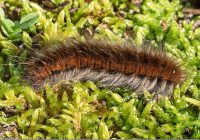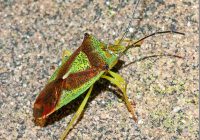Dr Phil Smith’s Wildlife Notes
October 2019
It’s supposed to rain in October and this year it did, 18 days having measurable rainfall, though in no great quantity. Nevertheless, it raised the dune water-table by about 15 cm (6 inches), with plenty of surface water at last in the Devil’s Hole. These damp conditions proved ideal for fungi, a highlight being the discovery by Trevor Davenport of the extremely rare Stereopsis reidii on the edge of a woodland path at Ainsdale National Nature Reserve. This caused a lot of excitement amongst mycologists, as there are few locations for the fungus in Europe and this was only the second British record, the previous also being at Ainsdale NNR.
On brighter days, I spent a good deal of time visiting patches of flowering Ivy; these attracted a great variety of insects despite the cooler temperatures of autumn. Early in the month, one of my favourite Ivy sites on the south-facing edge of Ravenmeols woods had up to 17 Red Admirals and two Commas. Eight species of hoverflies were usually present, including, on two occasions, the spectacular Hornet Hoverfly. It’s always a thrill to see this dramatic, brightly coloured insect, the largest of its family. A female on 27th was the latest of this species so far recorded in the region. Even better, though, was my first confirmed Formby Ivy Bee on 12th, followed by another on 27th. This distinctive solitary bee is now well established at Crosby but, apart from a sighting in south Liverpool, it has so far proved elusive elsewhere in north Merseyside. Late dragonflies also featured at Ravenmeols, as many as 12 Common Darters sunning themselves on a pile of logs, while a Migrant Hawker appeared on 21st. I particularly enjoyed a walk from Range Lane to Ravenmeols on 15th. The only sounds were two Buzzards mewing overhead and the rattle of dead Black Poplar leaves in the gentle breeze. A big hairy Fox Moth caterpillar was basking by the path side, while a Small Copper dazzled briefly on Ragwort flowers before I reached the Ivy, with its usual compliment of hoverflies, Red Admirals and Commas.
Provoked by a stream of emails from Pete Kinsella, I also made a few trips to Crosby Coastal Park, where Ivy Bees were usually to be seen and a colourful Hawthorn Shieldbug was a distraction. My main target, however, was a strange-looking hoverfly, Eristalinus aeneus, also known as the Large Spotty-eyed Dronefly. Pete had reported several and I finally caught up with one on the Blucher Street Ivy on 16th. This otherwise dull insect has amazingly pattered eyes and is not easy to find, being predominantly coastal with scattered records, mostly near rocky shores and saltmarsh in the south and west.
While I am reluctant to give up my passion for insects, as autumn progresses, inevitably other groups vie for attention. The Alt Estuary’s wader roost at Hightown is always worth a look on a big tide, as on 29th. Oblivious to the rattle of small arms on the adjacent Rifle Range, a flock of 900 Oystercatchers was an impressive sight. At least 500 Curlews were already dispersing across mudflats exposed by the falling tide. Yelping Redshanks flew down-river, while two Grey Herons stood mournfully on the tideline. An unexpected sight was a solitary Rabbit on the Altcar fore-dunes, most of its compatriots having long gone from this area of duneland. Skirting round the large reed-bed, I heard the “squealy-pig” call of the Water Rail and was surprised to see the dead flower-heads of 30 Giant Hogweed plants, not noticed here before. There was no sign of the Common Seal reported in recent months. While the Grey Seal is seen regularly, its smaller relative has only been recorded twice previously on the Sefton Coast.
Marshside on the Ribble Estuary is also a great attraction at this time of year. Flights of Pink-footed Geese were almost constantly overhead, while the regular flock of Icelandic Black-tailed Godwits built up to about 2700. Less expected was the Cetti’s Warbler that I heard singing on three occasions from scrub by the Hesketh Road viewing platform.
October is the month when dune management really kicks in. My ‘Buckthorn Bashers’ met three times , a good turnout of up to 14 volunteers clearing invasive Sea Buckthorn from the dunes north of Shore Road, Ainsdale. More valuable scrub clearance work was carried out by Green Sefton at Falklands Way and by Gems in the Dunes at Ainsdale Local Nature Reserve. I was delighted to see that young Gorse has been cut back around ponds on the Wildlife Trust’s Freshfield Dune Heath Nature Reserve. I also attended a field meeting at Hightown with Dynamic Dunescapes staff to examine the extent of Japanese Rose infestation, a volunteer survey in 2014 highlighting Hightown dunes as one of the worst areas for this invasive garden-escape. We saw how patches of the rose mapped earlier had grown much bigger, with new clumps arising since the survey. The Dynamic Dunescapes project, supported by European LIFE and Heritage Lottery funding, hopes to tackle this, amongst several other major issues affecting sand-dune biodiversity on the Sefton Coast.





